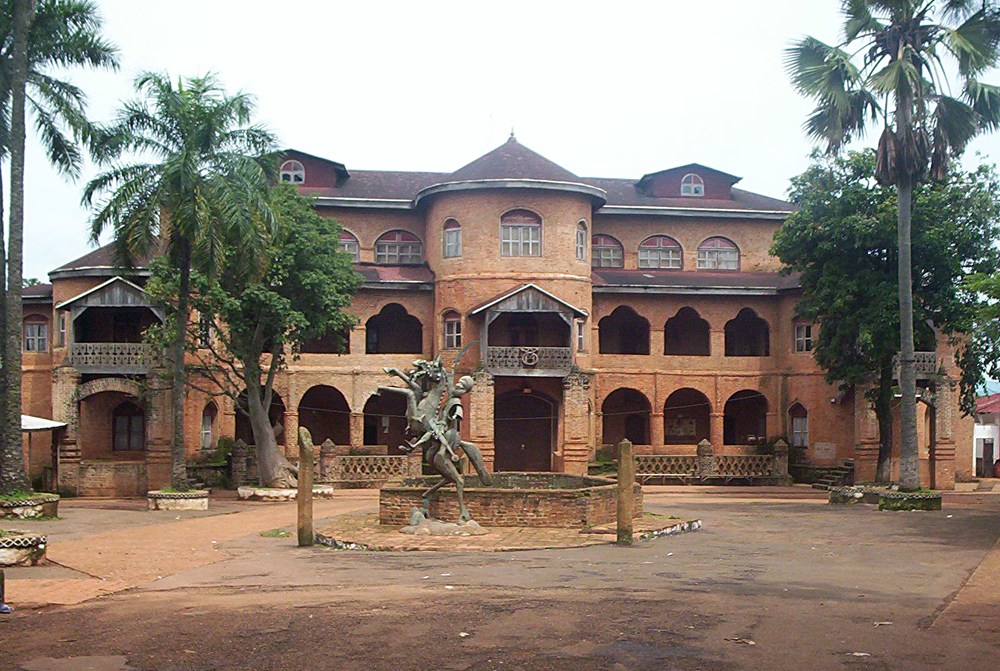Foumban Royal Palace on:
[Wikipedia]
[Google]
[Amazon]
 The Foumban Royal Palace is a historical building in the city of
The Foumban Royal Palace is a historical building in the city of
 The Foumban Royal Palace is a historical building in the city of
The Foumban Royal Palace is a historical building in the city of Foumban
Foumban or Fumban is a city in Cameroon, lying north east of Bafoussam. It has a population of 83,522 (at the 2005 Census). It is a major town for the Bamoun people and is home to a museum of traditional arts and culture. Foumban is known fo ...
, capital of Noun
A noun () is a word that generally functions as the name of a specific object or set of objects, such as living creatures, places, actions, qualities, states of existence, or ideas.Example nouns for:
* Living creatures (including people, alive, d ...
. It is the seat of the Kingdom of Bamum
The Kingdom of Bamoun (also spelled Bamoum, Bamun, Bamoun, or Mum) (1394–c. 1916) is a pre-colonial Central African state in what is now northwest Cameroon. It was founded by the Bamum people, Bamun, an ethnic group from northeast Cameroon. Its c ...
, where the Chief-Superior of the peoples of the valley of the East bank of the Noun resides.
The royal palace of Foumban, where the king of the Bamum still resides today, was built in 1917. The Palace Museum tells the history of the dynasty of the Bamum kings from 1394 to the present day, with information on the most famous of the Bamum kings, Ibrahim Njoya
King Ibrahim Mbouombouo Njoya ( Bamum: , ''Iparəim Nʃuɔiya'', formerly spelled in Bamum as , and Germanicized as ''Njoja'') in Yaoundé, was seventeenth in a long dynasty of kings that ruled over Bamum and its people in western Cameroon dati ...
, who died in 1933 and who created a writing system at the end of the 19th century called Bamum script
The Bamum scripts are an evolutionary series of six scripts created for the Bamum language by Ibrahim Njoya, King of Bamum (now western Cameroon) at the turn of the 19th century. They are notable for evolving from a pictographic system to a s ...
.
Bibliography
* Christraud M. Geary, The Things of the Palace: Catalog of the Bamoum Palace Museum in Foumban, Franz Steiner Verlag GMBH, Wiesbaden, 1984 * Adamou Ndam Njoya, The palace of Foumban: a masterpiece of art and architecture, Editions Ndam and Raynier, Yaounde, Foumban, 1975, 48 p.See also
*Kingdom of Bamum
The Kingdom of Bamoun (also spelled Bamoum, Bamun, Bamoun, or Mum) (1394–c. 1916) is a pre-colonial Central African state in what is now northwest Cameroon. It was founded by the Bamum people, Bamun, an ethnic group from northeast Cameroon. Its c ...
* Foumban
Foumban or Fumban is a city in Cameroon, lying north east of Bafoussam. It has a population of 83,522 (at the 2005 Census). It is a major town for the Bamoun people and is home to a museum of traditional arts and culture. Foumban is known fo ...
* Bamum people
The Bamum, sometimes called Bamoum, Bamun, Bamoun, or Mum, are a Grassfields languages, Grassfields ethnic group of Cameroon with around 215,000 members.
Religion
The Bamum traditional religion placed great emphasis on ancestral spirits which w ...
* Ibrahim Njoya
King Ibrahim Mbouombouo Njoya ( Bamum: , ''Iparəim Nʃuɔiya'', formerly spelled in Bamum as , and Germanicized as ''Njoja'') in Yaoundé, was seventeenth in a long dynasty of kings that ruled over Bamum and its people in western Cameroon dati ...
* Bamum language
Bamum (Shü Pamom "language of the Bamum", or ''Shümom'' "Mum language"), also spelled Bamun or in its French spelling Bamoun, is an Eastern Grassfields language of Cameroon, with approximately 420,000 speakers. The language is well known for ...
References
{{ReflistExternal links
http://aflit.arts.uwa.edu.au/IneditAssigaAhanda.html Historic sites in Cameroon Royal residences Residential buildings in Cameroon Palaces in Africa Museums in Cameroon Historic house museums in Africa Biographical museums in Africa West Region (Cameroon)